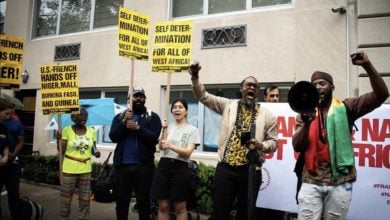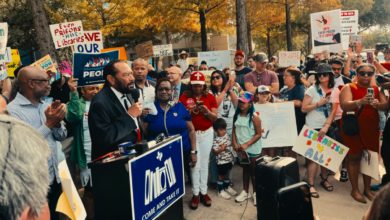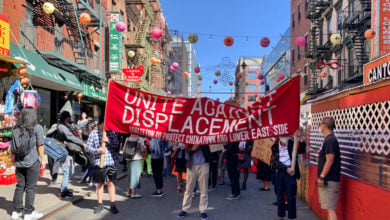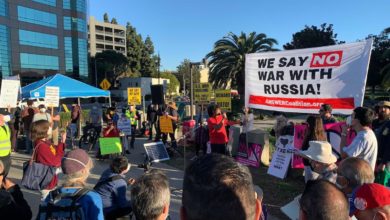In April 1968, a student revolt erupted at Columbia University. The protests had two main goals. One, the students wanted to end the administration’s involvement with a military think tank linked to the Vietnam war. Two, they opposed the university’s plan to build a gymnasium in a nearby Harlem park despite the objections of community members. They condemned this expansion plan as a policy of “Gym Crow.”
In the course of the revolt, students stopped classes, held rallies, took over the campus, and occupied the offices of administrators, declaring that the Ivy League university now belonged to the people. After nearly a week of student control, New York City police led a siege of the campus, injuring 150 students and arresting nearly 700 protesters. Although the revolt was put down, Columbia disaffiliated from the military think tank and scrapped the plans for the controversial gym.

The following article was published by the student newspaper, the Spectator, as part of a series to commemorate the 40th anniversary of the 1968 student revolt. The author, Karina Garcia, is a student leader at Columbia and a founder of the activist group Lucha. Although written for a Columbia audience, Garcia’s main point about the connection between on-campus struggle and broader social movements is relevant to student activists everywhere.
In commemorating the 40th anniversary of the 1968 Columbia student revolt, there are three dangers. One is to use the occasion as simply an opportunity for empty nostalgia, self-reflection, or in the case of many ex-radicals, self-criticism. The second danger is to forget that the students won their demands. The third danger is to approach it as an event that belongs exclusively to the University, as if the chemicals that caused the combustion were organic to this campus alone.
This was the era of the Kent State and Jackson State massacres. 1968 was a year of near revolution in France, the Rodney Riots in Jamaica, and the Tlatelolco massacre of university students in Mexico City. Each uprising had its own particular history and localized causes, but taken together, they clearly constitute an international phenomenon.
The students of 1968 were neither the first nor the last group of students that made protesting a way of life. Just at Columbia alone, it seems the Sundial rarely gets a day off. So what about 1968 was different?
The case of Columbia is instructive. The 1968 demonstrations started with the demand that the University cease to provide weapons research for the U.S. Department of State. But in short order and with no apparent reservation, the students united with Harlem residents against Columbia’s racist expansionist policies. In doing so, they struck down all established divisions between local and international politics, on- and off-campus issues.
The revolt belonged neither to the anti-war movement, the Black liberation movement, nor the student movement. What began as a narrow and contained protest against the administration turned into a generalized struggle against the establishment in all its forms.
What does this mean for Columbia today? Too often in our protests against the administration, let alone the government, we activists make demands from a position of weakness. We lack the force and the offensive character that made the ’68 protests so potent.
The school was certainly no less elite then than it is now. In fact, its composition was less diverse in terms of both socioeconomic background and ethnicity. Those students did not put their bodies and student careers on the line because of any special characteristics. They were not naturally imbued with any internal fountains of radicalism and militancy. What made the ’68 student revolt special was that it was not special at all.
We can’t go back and peer into the minds of the Columbia student protesters to see if they had psychologically ceased to think of themselves as elite students. But we know that objectively, they had ceased to respect the boundaries between student and worker, Columbia and Harlem. This is what encouraged them to take risks. They knew they stood with the people. Solidarity was not an abstract concept. It was empirical and right in front of them.
It was not the cultural revolution of the late 1960s—sex, drugs, and rock-and-roll—that terrified the authorities. In the end, all of these could be sufficiently commodified. And to be frank, we should only prioritize in our own activism that which has the potential to terrify them. They don’t give us anything unless they’re on the defensive. It was generalized social movement that was able to extract from the government meaningful reforms like civil rights, women’s rights, LGBT rights, and affirmative action.
We radicals at Columbia can’t expect to win anything substantial within the confines of the elite campus. As long as we support full rights for all immigrants, Harlem’s right to determine its own destiny, and an immediate end to the occupations of Iraq and Palestine, we will be shunned by a broad section of the political spectrum. It does not matter how we articulate these goals. It is what we represent that offends them.
We don’t embrace or take foolish pride in isolation, but we in Lucha have decided to formulate our tactics, positions, and strategies based on the needs of the movement and our broader community, not the sensibilities of the “campus community.”
On Oct. 4, 2006, some of us refused to sit on the sidelines and watch the Minutemen, the vigilante terrorists that brutalize our communities, get a chance to come to campus unchallenged.
When we confronted the racist anti-immigrant vigilantes of the Minuteman Project, we did so because we considered ourselves a detachment of the broader immigrant rights movement that flourished earlier that year. We knew we were speaking for all the spat on day laborers too afraid to hit back. We were denounced as “animals” and enemies of free speech, and several of our members, myself included, were subject to disciplinary procedures. But we, like the ’68 student activists who were also disciplined, had made our point.
Our experience as activists have taught us that there is only one way of overcoming isolation on this campus without compromising our principles, and that is to connect with the outside community.
We do not connect with off-campus organizations simply to increase attendance at our events, or as some sort of goodwill to the outside community. Rather, we know that the political, class, and demographic composition of the “off-campus” community makes it our only reliable basis of support and at times of hardship, our only refuge.
Yes, we are a part of Columbia University. We take classes here, we reside in the dorms, and we should of course try our hardest to push the school in a progressive direction. But we should not confuse it with home. We don’t embrace on-campus isolation, but we’ll risk it.
Activists should not honor the ’68 student revolt by mimicking its every move or idolizing individual leaders. But there is a powerful lesson we can learn nonetheless. When a wave of radicalism splashes onto the shores of Columbia, don’t just analyze it—jump in.






